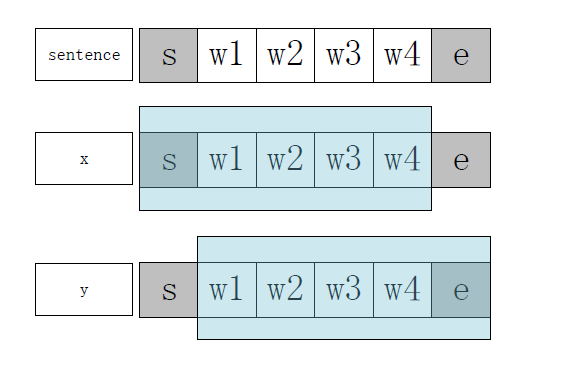RNN学习笔记(五)-RNN 代码实现
1.语言模型(LM)简述
做过NLP任务的童鞋应该都知道什么是语言模型,简单来说,如果我们把一句话s看做是由若干个(n个)词w组成的集合,那么这句话生成的概率就为:
P(s)=p(w1,w2,...,wn)=p(w1)p(w2|w1)p(w3|w1,w2)...p(wn|w1,...,wn−1)
显然,右边的式子非常难以计算,它需要估算n个联合条件分布率。通常我们会做一些假设,比如,假设每个词的出现只依赖它的前一个词。那么上式就可以化简为:
P(s)=p(w1)p(w2|w1)p(w3|w2)...p(wn|wn−1)
如果依赖与前两个词:
P(s)=p(w1)p(w2|w1)p(w3|w1,w2)...p(wn|wn−2,wn−1)
以上分别被称为2-Gram和3-Gram,对应的可以定义出4-Gram,5-Gram等等。前面关联的词越多,模型就越精确,相应的训练成本就越大。
在这里,为了简单起见,我们将通过RNN来训练一个2-Gram。即通过RNN来估计出每对单词的条件概率 p(wi|wj)
2.RNN网络结构
训练样本(sentence)数为 Ns ,目标词典的word数量为 Nw ,每个单词使用one-hot表示(即该单词在词典中的Index),输入(出)层节点数 Ni=No=Nw 其中隐层节点数为 Nh (通常为N_i的十分之一左右)。隐层节点激活函数为tanh,输出层节点激活函数为softmax。隐层存在一个递归边,每一时刻的输出乘以权值矩阵W后将作为下一时刻输入的一部分。
权值矩阵:
U:Input Layer->Hidden(t) Layer,大小为( Nh×Ni )
V:Hidden(t) Layer->Output Layer,大小为( No×Nh )
W:Hidden(t-1) Layer->Hidden(t) Layer,大小为( Nh×Nh )
fh :隐层激活函数
fo :输出层激活函数
sk(t) :t时刻第k个隐层节点的输出值
ok(t) :t时刻第k个输出层节点的输出值
yk :第k个输出层节点的目标输出值(即学习signal)

如上图所示,整个网络可以在时间上无限延展,每个时刻t网络都有一个对应的输入向量 x(t) ,一个隐层输出(状态)向量 s(t) ,一个输出向量 o(t) 。
输入向量 x(t) 和期望输出向量 y(t) 结构如下(假设输入的sentence由4个words组成):

可以看到,y刚好相对于x有一个时刻的偏移,即: y(t)=x(t+1)
因此,t时刻的损失函数通过 y(t) 和 o(t) 即可求出。具体计算方法参见下边的小节。
3.python代码分析
这里我们使用python的Numpy包来实现,类名为RNNNumpy。另外代码中有中文注释,如果pydev中运行报错,在py文件最开始加上“#coding=utf-8”
3.0 主程序中的关键代码
3.0.1 文件读取
按行读取文件,每一行为一个句子(sentence),并在每个句子的开头和结尾添加SENTENCE_START及SENTENCE_END word。
# with open('data/script.txt', 'rb') as f:
with open('data/script.txt', 'rb') as f:
reader = csv.reader(f, skipinitialspace=True)
reader.next()
# Split full comments into sentences
sentences = itertools.chain(*[nltk.sent_tokenize(x[0].decode('utf-8').lower()) for x in reader])
# Append SENTENCE_START and SENTENCE_END
sentences = ["%s %s %s" % (sentence_start_token, x, sentence_end_token) for x in sentences]
print "Parsed %d sentences." % (len(sentences))3.0.2 分词及词频信息统计
vocabulary_size:词典的大小,即 Nw 。这里取训练语料经过分词后所有不重复词的数目;
tokenized_sentences:分词后的句子,每个句子由一个word的list组成,分词使用最简单的按空格
切分的方式,如果需要处理中文可以先使用中文专用的分词器切分语料;
word_freq:每个词在语料中出现的次数
# Tokenize the sentences into words
tokenized_sentences = [nltk.word_tokenize(sent) for sent in sentences]
# Count the word frequencies
word_freq = nltk.FreqDist(itertools.chain(*tokenized_sentences))
vocabulary_size = len(word_freq.items())3.0.3 去除低频词、word转index
vocab:只存储词典中出现频率排名前 Nw−1 的词(相当于去掉了出现频率最低的词)
word_to_index:word到index的映射表
# Get the most common words and build index_to_word and word_to_index vectors
vocab = word_freq.most_common(vocabulary_size-1)
#将词典中所有的词(非重复)存储在index_to_word中
index_to_word = [x[0] for x in vocab]
#添加为登录词标记
index_to_word.append(unknown_token)
word_to_index = dict([(w,i) for i,w in enumerate(index_to_word)])3.0.4 去除停用词
# Replace all words not in our vocabulary with the unknown token
for i, sent in enumerate(tokenized_sentences):
tokenized_sentences[i] = [w if w in word_to_index else unknown_token for w in sent]3.0.5 生成训练数据
X_train:即公式中的输入x,取每个sentence word index list的前T-1个元素,X_train中每一行存储的是每个句子从t=0时刻到t=T-2时刻的word index,T为该句子的长度;
y_train:即公式中的训练数据 y ,取每个sentence word index list的后T-1个元素(除去第一个元素),y_train中每一行存储的是每个句子从t=1时刻到t=T-1时刻的word index;
# Create the training data
X_train = np.asarray([[word_to_index[w] for w in sent[:-1]] for sent in tokenized_sentences])
y_train = np.asarray([[word_to_index[w] for w in sent[1:]] for sent in tokenized_sentences])3.0.6 构建模型类
model = RNNNumpy(vocabulary_size, hidden_dim=_HIDDEN_DIM)3.0.7 模型训练
def train_with_sgd(model, X_train, y_train, learning_rate=0.005, nepoch=1, evaluate_loss_after=5):
"""
Train RNN Model with SGD algorithm.
Parameters
----------
model : The model that will be trained
X_train : input x
y_train:期望输出值
learning_rate:学习率
nepoch:迭代次数
evaluate_loss_after:loss值估计间隔,训练程序将每迭代evaluate_loss_after次进行一次loss值估计
"""
# We keep track of the losses so we can plot them later
losses = []
num_examples_seen = 0
#循环迭代训练,这个for循环每运行一次,就完成一次对所有数据的迭代
for epoch in range(nepoch):
# Optionally evaluate the loss
if (epoch % evaluate_loss_after == 0):
loss = model.calculate_loss(X_train, y_train)
losses.append((num_examples_seen, loss))
time = datetime.now().strftime('%Y-%m-%d-%H-%M-%S')
print "%s: Loss after num_examples_seen=%d epoch=%d: %f" % (time, num_examples_seen, epoch, loss)
# Adjust the learning rate if loss increases
#如果当前一次loss值大于上一次,则调小学习率
if (len(losses) > 1 and losses[-1][1] > losses[-2][1]):
learning_rate = learning_rate * 0.5
print "Setting learning rate to %f" % learning_rate
sys.stdout.flush()
# ADDED! Saving model oarameters
save_model_parameters_theano("./data/rnn-theano-%d-%d-%s.npz" % (model.hidden_dim, model.word_dim, time), model)
# For each training example...
#对所有训练数据执行一轮SGD算法迭代
for i in range(len(y_train)):
# One SGD step
model.sgd_step(X_train[i], y_train[i], learning_rate)
num_examples_seen += 13.0.8 辅助函数
辅助函数在utils.py中,这里不做过多解释,相信大家都能看懂:
def softmax(x):
xt = np.exp(x - np.max(x))
return xt / np.sum(xt)
def save_model_parameters_theano(outfile, model):
U, V, W = model.U.get_value(), model.V.get_value(), model.W.get_value()
np.savez(outfile, U=U, V=V, W=W)
print "Saved model parameters to %s." % outfile
def load_model_parameters_theano(path, model):
npzfile = np.load(path)
U, V, W = npzfile["U"], npzfile["V"], npzfile["W"]
model.hidden_dim = U.shape[0]
model.word_dim = U.shape[1]
model.U.set_value(U)
model.V.set_value(V)
model.W.set_value(W)
print "Loaded model parameters from %s. hidden_dim=%d word_dim=%d" % (path, U.shape[0], U.shape[1])3.1 RNN实现类RNNNumpy
3.1.1 初始化
def __init__(self, word_dim, hidden_dim=100, bptt_truncate=4):
"""
Instantiates the RNN class.
Parameters
----------
word_dim : 输入词向量的维度,如果是one hot,显然应该等于Input Layer 的结点数
hidden_dim : 隐层的结点数
bptt_truncate:BPTT反向传播的时间范围
"""
# Assign instance variables
self.word_dim = word_dim
self.hidden_dim = hidden_dim
self.bptt_truncate = bptt_truncate
# Randomly initialize the network parameters
self.U = np.random.uniform(-np.sqrt(1./word_dim), np.sqrt(1./word_dim), (hidden_dim, word_dim))
self.V = np.random.uniform(-np.sqrt(1./hidden_dim), np.sqrt(1./hidden_dim), (word_dim, hidden_dim))
self.W = np.random.uniform(-np.sqrt(1./hidden_dim), np.sqrt(1./hidden_dim), (hidden_dim, hidden_dim))3.1.2 前向传播
前向传播对应的公式如下:
fo(x,z)=softmax(x)=








 这篇博客详细介绍了RNN(循环神经网络)在语言模型(LM)中的应用,特别是2-Gram模型。博客首先概述了语言模型的基本概念,然后讨论了RNN的网络结构。接着,重点转向Python代码实现,包括文件读取、分词处理、模型构建和训练过程,特别是使用Numpy库。最后,提到了Matlab中的实现步骤,并提供了相关参考资源。
这篇博客详细介绍了RNN(循环神经网络)在语言模型(LM)中的应用,特别是2-Gram模型。博客首先概述了语言模型的基本概念,然后讨论了RNN的网络结构。接着,重点转向Python代码实现,包括文件读取、分词处理、模型构建和训练过程,特别是使用Numpy库。最后,提到了Matlab中的实现步骤,并提供了相关参考资源。
 最低0.47元/天 解锁文章
最低0.47元/天 解锁文章















 562
562

 被折叠的 条评论
为什么被折叠?
被折叠的 条评论
为什么被折叠?








